You’ll discover that Western Washington’s unique maritime climate creates perfect conditions for an impressive array of native plants. The region’s mild, wet winters and relatively dry summers, combined with acidic soils, support everything from towering conifers to delicate woodland flowers. Whether you’re planning a rain garden or designing drought-tolerant borders, these indigenous species offer remarkable adaptability. However, choosing the wrong plants for your specific microclimate can lead to disappointing results, so understanding each species’ particular requirements becomes essential.
Contents
- 1 Western Washington’s Maritime Climate Overview
- 2 Stunning Wildflowers for Western Washington
- 3 Majestic Evergreens for Western Washington
- 4 Versatile Native Shrubs for Landscaping
- 5 Selecting the Right Native Plants for Your Garden
- 6 Frequently Asked Questions
- 6.1 How Much Do Native Plants Typically Cost Compared to Non-Native Alternatives?
- 6.2 Where Can I Purchase Native Plants in Western Washington?
- 6.3 When Is the Best Time to Plant Native Species?
- 6.4 Do Native Plants Require Special Fertilizers or Soil Amendments?
- 6.5 How Long Does It Take for Native Plants to Establish?
Western Washington’s Maritime Climate Overview
When you step into Western Washington’s climate zone, you’re entering a region shaped entirely by the Pacific Ocean’s steady influence. This maritime climate creates perfect conditions for native plant adaptation, with temperatures rarely exceeding 79°F in summer or dropping below 45°F in winter.
You’ll notice the climate impact through consistent moisture levels, receiving 50-250 inches of annual precipitation. The ocean moderates temperature extremes, maintaining year-round stability that native plants have evolved to thrive in.
This equable climate, combined with frequent fog and marine pushes, creates ideal growing conditions for indigenous vegetation. The region experiences orographic lifting along the western slopes, which enhances precipitation patterns that support diverse native plant communities.
Stunning Wildflowers for Western Washington
Western Washington’s diverse ecosystems support an array of stunning native wildflowers, from colorful meadow standouts to delicate shade dwellers, moisture-loving species, and hardy prairie blooms. These resilient plants include species like Fireweed, which is famous for regrowth after forest fires and other natural disturbances.
Western Bleeding Heart (Dicentra)
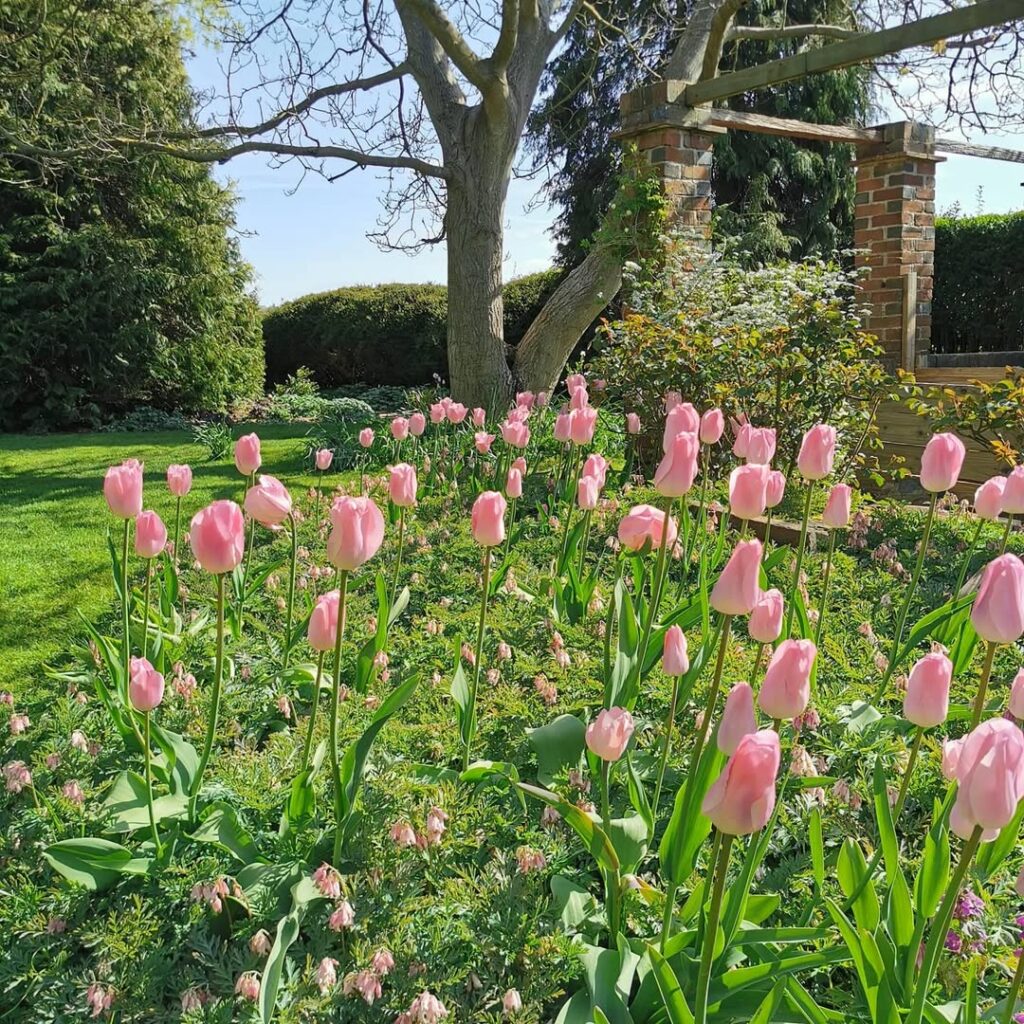
Western Bleeding Heart (Dicentra formosa) is a stunning native wildflower that brings delicate beauty to Western Washington gardens. This charming perennial produces clusters of heart-shaped pink to rose-purple flowers with distinctive spurred petals above finely divided, bluish-green foliage. Growing 12-18 inches tall and spreading 24-36 inches wide, it creates an elegant groundcover in shaded areas.
Blooming from early spring through summer, Western Bleeding Heart naturally goes dormant during hot, dry periods but may produce additional flowers in fall with adequate moisture. Its deer and rabbit resistance, combined with its ability to attract pollinators, makes it an excellent choice for native plant gardens and naturalized woodland settings. The plant provides essential habitat for Clodius parnassian butterfly larvae, which feed on the foliage as part of their natural lifecycle.
- Hardiness: Cold hardy, withstands Pacific Northwest winters
- Light: Part to full shade; some sun tolerance in cooler climates
- Water: Moderate to high moisture; prefers consistent water but tolerates summer dormancy
- Soil: Moist, well-drained soils rich in humus; acidic forest soil preferred
- Fertilizer: Low requirements; benefits from organic matter and leaf mold
- Pest/Disease Resistance: Naturally resistant to deer and rabbits; generally disease-free
- Growth Rate: Moderate; spreads via fleshy roots to form colonies
Trillium (Three-petaled Beauty)
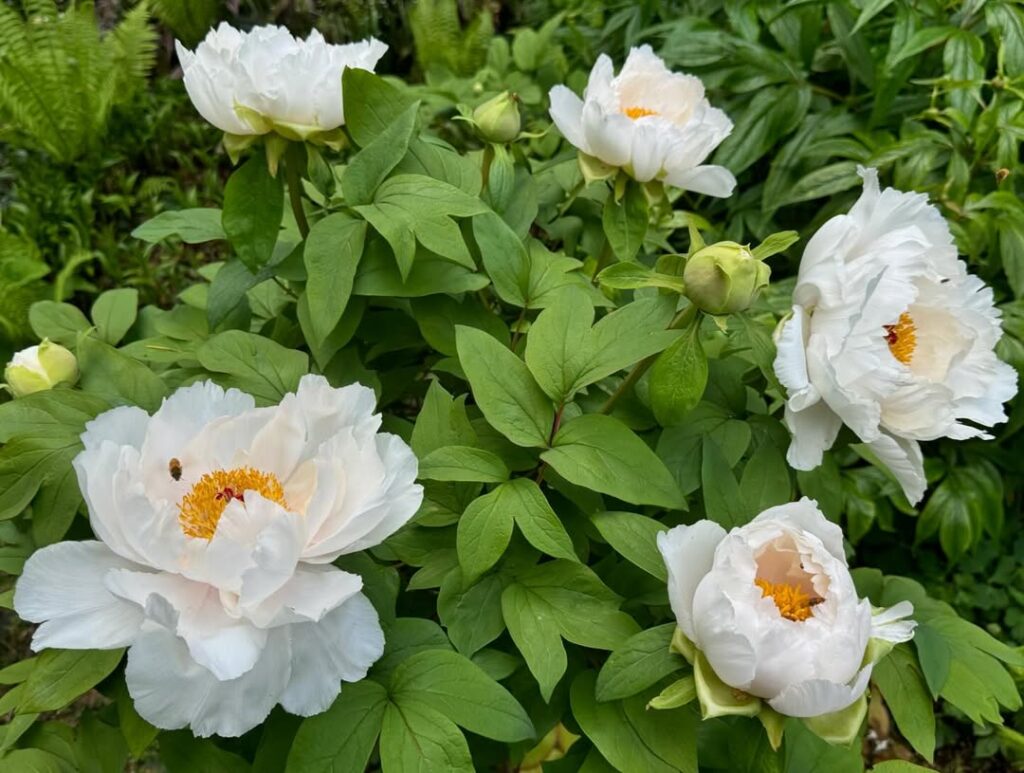
Trillium ovatum, known as Western Trillium or wake robin, is a beloved native perennial that signals spring’s arrival throughout the Pacific Northwest. This distinctive wildflower features three broad leaves topped by a single three-petaled flower that shifts from white to pink to purple as it ages. Blooming from March to July, this slow-growing but long-lived plant creates stunning woodland displays.
Growing from rhizomes, mature trilliums form expanding clumps that become more spectacular with age, reaching 4-18 inches tall and spreading 6-24 inches wide. The plant completely dies back to its underground bulb after flowering, remaining dormant until the following spring. Several regional varieties exist, including the rare T. parviflorum found only in Southwest Washington and Northwest Oregon. These remarkable plants can take up to 10 years to produce their first flower when grown from seed.
- Hardiness: Zones 5-9, fully cold hardy in Western Washington
- Light: Full shade to part-shade; mimics natural forest understory conditions
- Water: Consistent moisture during growing season; avoid waterlogged conditions
- Soil: Moist, well-drained, humus-rich woodland soil with good organic content
- Fertilizer: Light application of organic compost; avoid heavy fertilization
- Pest/Disease Resistance: Generally pest-free; susceptible to slug damage on emerging shoots
- Growth Rate: Very slow establishment; long-lived once mature
Pacific Lupine (Purple Spikes)

Pacific Lupine stands as one of western Washington’s most striking wildflowers, displaying tall purple flower spikes that can reach 2-4 feet in height. This perennial member of the pea family creates dramatic vertical elements in the landscape with its distinctive palmately divided leaves and densely branched structure. The vibrant blooms range from deep purple and blue to occasional white or pink variants, providing spectacular color during late spring and early summer flowering periods.
Beyond its ornamental appeal, Pacific Lupine serves essential ecological functions as a nitrogen-fixing legume that enriches soil fertility while supporting native pollinators including bees, butterflies, and hummingbirds. Its extensive root system, anchored by a woody caudex, promotes soil stability and adaptation to diverse habitats from coastal regions to subalpine meadows. This species is also referred to as Arctic lupine in northern regions, reflecting its remarkable cold tolerance and adaptability. Once established, this low-maintenance native thrives with minimal intervention, making it ideal for naturalized plantings and pollinator gardens throughout western Washington’s varied ecosystems.
- Hardiness: Zones 3-9, tolerates local weather extremes and seasonal climate variability
- Light: Full sun to partial shade, adaptable to varied light conditions
- Water: Low to moderate; drought tolerant once established, adapts to wet and dry conditions
- Soil: Well-draining to moist soils, tolerates varied soil types and pH levels
- Fertilizer: None required; nitrogen-fixing capabilities enhance soil naturally
- Pest/Disease Resistance: High resistance due to genetic diversity among species
- Growth Rate: Moderate; establishes quickly and adapts rapidly to local conditions
Yarrow (White Flat Clusters)
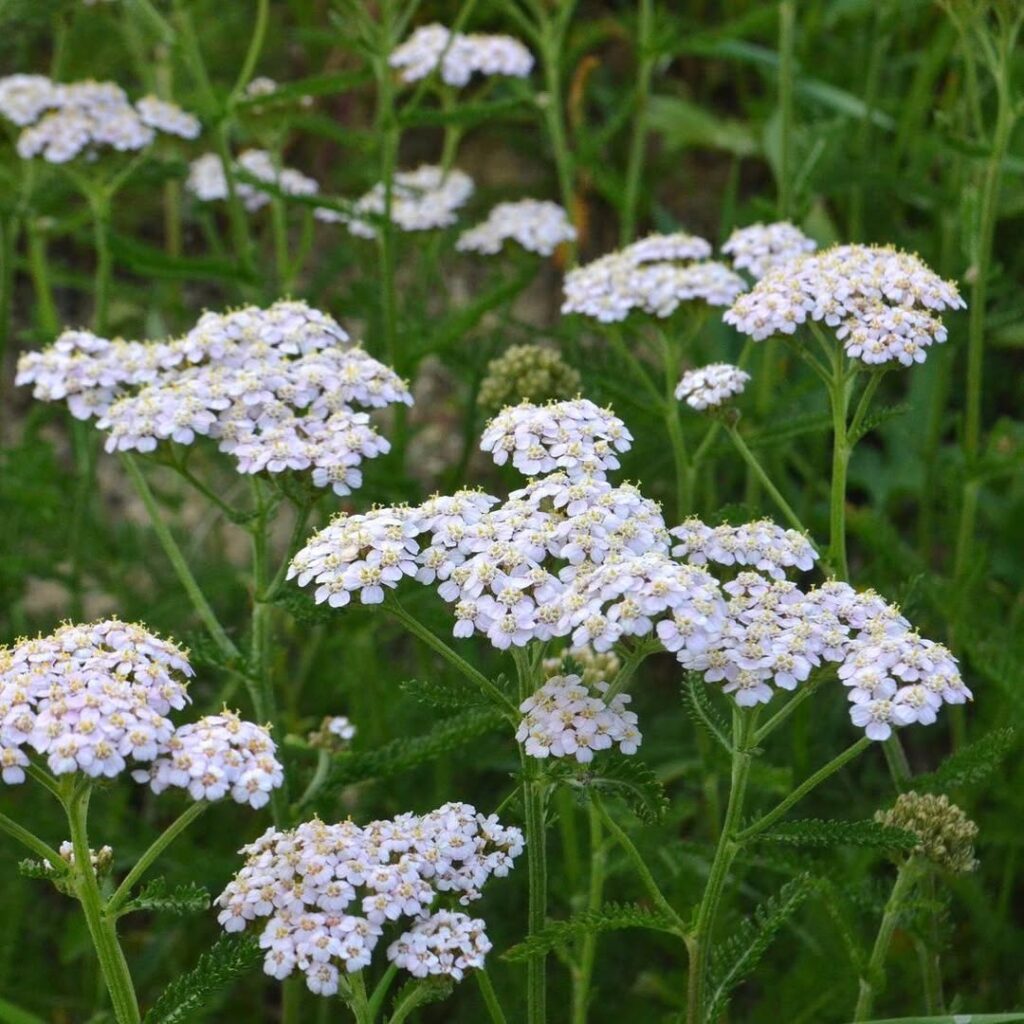
This extremely drought-tolerant wildflower blooms from May through September, making it an excellent choice for Western Washington native gardens. Its spreading habit creates established colonies over time through creeping rhizomes, while the semi-evergreen foliage provides year-round garden interest. Yarrow attracts butterflies and pollinators while serving as important wildlife habitat, and its aromatic compounds protect it from overgrazing. The fern-like foliage adds delicate texture to garden compositions with its alternate leaves reaching 3-5 inches in length.
- Hardiness: Very hardy perennial, well-adapted to Western Washington climate
- Light: Full sun to partial sun
- Water: Very low water needs once established; extremely drought-tolerant
- Soil: Thrives in gravelly loam, sandy soils, and thin soils; widely adaptable
- Fertilizer: No fertilizer needed; thrives in poor soils
- Pest/Disease Resistance: Excellent resistance due to natural aromatic compounds
- Growth Rate: Moderate to fast spreading through creeping rhizomes
Camas (Blue Spring Blooms)

Camas is a stunning native bulb in the lily family that produces spectacular spikes of purple flowers rising 1-3 feet above graceful strap-like leaves. This signature wildflower of Western Washington prairies and meadows creates dramatic spring displays with dozens of showy blooms arranged in eye-catching racemes.
Beyond its ornamental value, camas holds deep cultural significance as a traditional food source for indigenous peoples. The nutritious bulbs develop a sweet, chestnut-like flavor when cooked. This resilient wildflower is considered among the easiest and most spectacular native bulbs for regional landscaping. Camas readily self-seeds in gardens, with offspring blooming in 3-4 years to create naturalized colonies.
- Hardiness: Hardy in Western Washington’s Coastal Douglas-fir Zone and dry sub-zones
- Light: Full sun exposure required for ideal flowering
- Water: Winter and spring moisture essential; drought tolerant once established; avoid fully dry soil during dormancy
- Soil: Heavy, moisture-retentive soils preferred; low tolerance for calcium carbonate (CaCO3)
- Fertilizer: Not typically required; thrives in native soil conditions
- Pest/Disease Resistance: Very tough and resilient once established
- Growth Rate: Moderate; goes dormant after flowering period
Majestic Evergreens for Western Washington
Western Washington’s towering evergreens define the region’s landscape, offering ecological benefits, cultural significance, and practical landscaping solutions through diverse species perfectly adapted to local conditions. These magnificent trees provide essential environmental services including shade, carbon storage, and water filtration while serving as vital wildlife habitat.
Douglas Fir (Towering Giants)
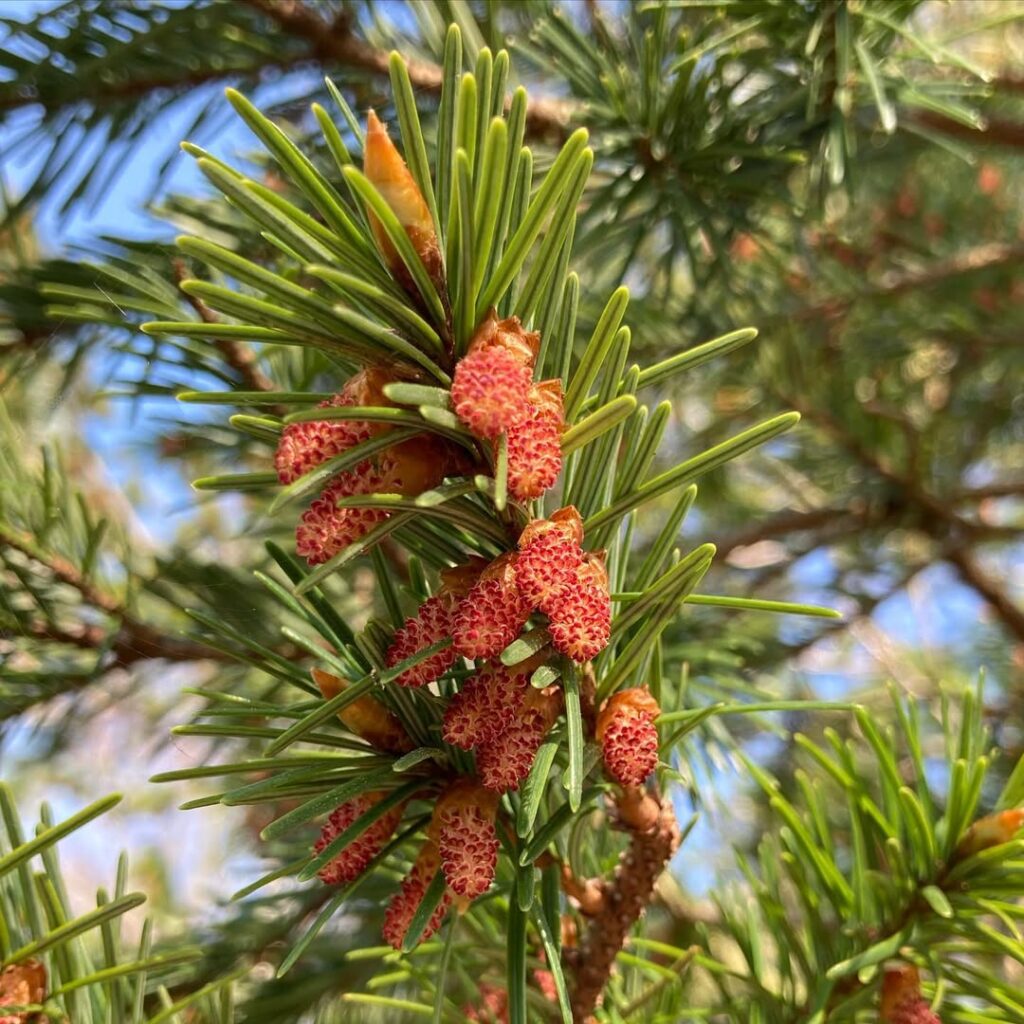
Douglas fir stands as one of the most iconic and majestic evergreens in Western Washington, reaching impressive heights of 125 feet or more with a distinctive pyramidal shape. These towering giants are characterized by their thick, fire-resistant bark and soft, deep green needles that may display a bluish tint. Their moderately hard, resin-rich wood contributes to exceptional longevity and natural resistance to decay and pests.
Beyond their impressive stature, Douglas firs provide essential habitat for endangered species like the northern spotted owl and marbled murrelet while supporting diverse understory communities. Long treasured by Indigenous peoples for construction, tools, and medicine, these trees symbolize the Pacific Northwest’s natural heritage and played a significant role in the region’s early settlement and economic development. The distinctive three-pointed bracts emerging from their reddish-brown cones make Douglas firs particularly easy to identify among other Pacific Northwest conifers.
- Hardiness: USDA zones 4-6, highly adaptable to Pacific Northwest conditions
- Light: Full sun to partial shade; shade tolerant when young, light-demanding as mature canopy species
- Water: Moderate; tolerates both dry and wet sites, adaptable to varying moisture conditions
- Soil: Wide range of soil types; thrives in well-draining soils from low elevations to mountainous regions
- Fertilizer: Generally not required; naturally adapted to native soil conditions
- Pest/Disease Resistance: High resin content deters bark beetles; thick bark provides fire resistance; mature trees resist decay
- Growth Rate: Moderate to fast; can pioneer disturbed sites while persisting in established forests
Western Hemlock (Graceful Drooping)
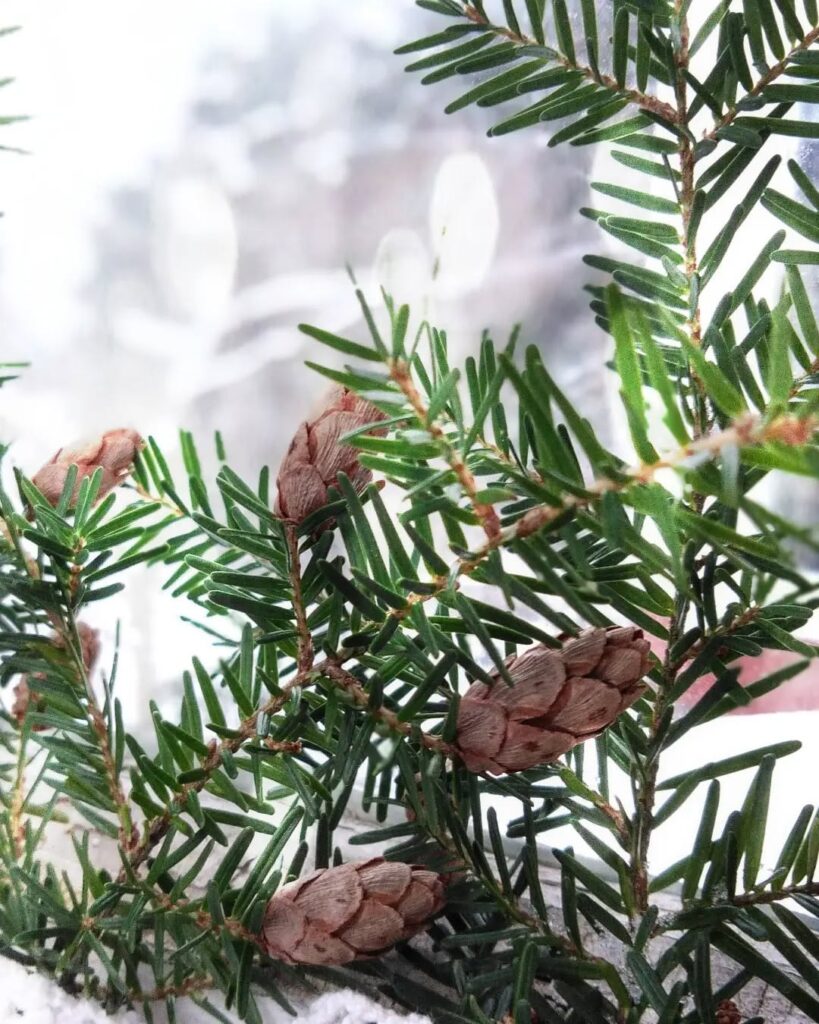
Western Hemlock is a majestic evergreen that can tower up to 83 meters tall, distinguished by its graceful drooping branchlet tips and pendulous leader. This shade-tolerant giant features short, flat needles with white undersides and develops a neat conic crown in youth that becomes cylindrical with age. As the largest hemlock species, it dominates old-growth forests in western Washington, often comprising over half the foliage in mature stands.
The species thrives in the Pacific Northwest’s wet climate and is exceptionally well-adapted to forest understories. Its prolific cone production and ability to colonize nurse logs make it an excellent regenerator, while its impressive longevity allows individual trees to reach centuries in age with minimal external aging indicators. Western Hemlock holds the distinction of being the state tree of Washington, reflecting its cultural and ecological importance to the region.
- Hardiness: Zones 6-8, extremely cold hardy in Pacific Northwest conditions
- Light: Full sun to full shade, exceptionally shade-tolerant
- Water: Moist to wet conditions, thrives in high rainfall environments
- Soil: Acidic, cool, well-draining soils, tolerates various soil types
- Fertilizer: Low maintenance, adapted to nutrient-poor forest soils
- Pest/Disease Resistance: Generally resistant when grown in ideal conditions
- Growth Rate: Moderate to slow, long-lived species reaching centuries in age
Western Red Cedar (Aromatic)

The Western Red Cedar is a magnificent evergreen coniferous tree native to the Pacific Northwest, capable of reaching massive proportions with specimens recorded up to 599 cm in diameter. These ancient giants can live well over 1,500 years, making them among the most long-lived trees in North America. Known for their aromatic wood and exceptional rot resistance, they hold immense cultural significance for First Nations peoples.
Western Red Cedars are “long distance runners” in forest succession, often remaining as minor components for centuries before achieving dominance in old-growth forests. They provide essential habitat for wildlife, offering thermal cover and stream shading for salmon. Their shallow root systems and moisture-loving nature make them particularly well-suited to riparian areas and coastal rainforests from Southern Oregon to British Columbia. The trees are easily recognized by their distinctive scale-like leaves that appear as flattened braids in lacy sprays with a sweet odor when crushed.
- Hardiness: USDA zones 6-8, thrives in Pacific Northwest climate
- Light: Full sun to partial shade, highly shade tolerant
- Water: High moisture requirements, prefers consistently moist to wet conditions
- Soil: Well-draining but moisture-retentive soils, tolerates various soil types including swampy conditions
- Fertilizer: Low requirements, benefits from organic matter in soil
- Pest/Disease Resistance: Generally good resistance, wood naturally rot-resistant
- Growth Rate: Slow to moderate, with true dominance achieved only with great age
Shore Pine (Coastal Resilience)

Shore Pine stands as a tribute to nature’s resilience along the Pacific Northwest coastline. Native to coastal regions of Washington, Oregon, and British Columbia, this hardy evergreen thrives in conditions that challenge most other trees. Its distinctive twisted and contorted form reflects years of adaptation to harsh coastal winds, salt spray, and sandy soils.
Reaching heights of 20-40 feet (up to 100 feet in ideal conditions), Shore Pine serves as both a landscape guardian and ecological cornerstone. Its dense, scaly bark and compact structure provide year-round wildlife habitat while stabilizing erosion-prone coastal soils. This fast-growing pine creates protective microclimates for understory plants and contributes notably to carbon sequestration, making it invaluable for both natural ecosystems and landscape restoration projects. The woody cones can remain attached to the tree for extended periods, eventually releasing highly nutritious seeds that support local bird and mammal populations.
- Hardiness: Zones 7-9, extremely tolerant of salt spray and coastal winds
- Light: Full sun preferred for ideal growth
- Water: Drought tolerant once established, requires minimal irrigation
- Soil: Well-drained sandy soils preferred, tolerates clay with adequate drainage, thrives in poor and rocky sites
- Fertilizer: None required, adapted to nutrient-poor coastal conditions
- Pest/Disease Resistance: Excellent resistance due to harsh coastal adaptations
- Growth Rate: Fast for a pine species, especially in suitable conditions
Grand Fir

Grand Fir is a magnificent native evergreen that can reach heights of 130-230 feet, making it one of western Washington’s most majestic conifers. This shade-tolerant species thrives in the region’s moist valleys and stream bottoms, typically between 600-1,000 feet elevation where annual precipitation ranges from 30-45 inches. With its flat, fragrant needles and distinctive upright cones, Grand Fir provides excellent wildlife habitat while serving as an impressive specimen for restoration and native landscaping projects.
While moderately shade tolerant, Grand Fir requires more light than Western Hemlock or Western Red Cedar to remain competitive. It performs best on rich, moist soils and struggles in dry, cold, or harsh conditions, making proper site selection essential for successful establishment. The species emits a distinctive balsamy scent that makes it particularly popular for Christmas tree use.
- Hardiness: USDA zones 6-8, cold-sensitive in harsh conditions
- Light: Partial shade to full sun, requires more light than other shade-tolerant conifers
- Water: Consistent moisture required, performs poorly in dry conditions
- Soil: Rich, moist, well-draining soils; excellent on river floodplains and upland forest sites
- Fertilizer: Generally not needed in suitable native soil conditions
- Pest/Disease Resistance: Moderate resistance, susceptible to stress-related issues in poor sites
- Growth Rate: Moderate to fast on favorable sites, slow on marginal sites
Versatile Native Shrubs for Landscaping
Pacific Northwest native shrubs offer exceptional landscaping versatility, thriving in diverse conditions while providing year-round beauty, wildlife habitat, and virtually maintenance-free gardens once established. These native species are available at affordable prices, with options like Salal starting as low as $4.95 and many popular varieties ranging from $12.95 to $24.95.
Oregon Grape
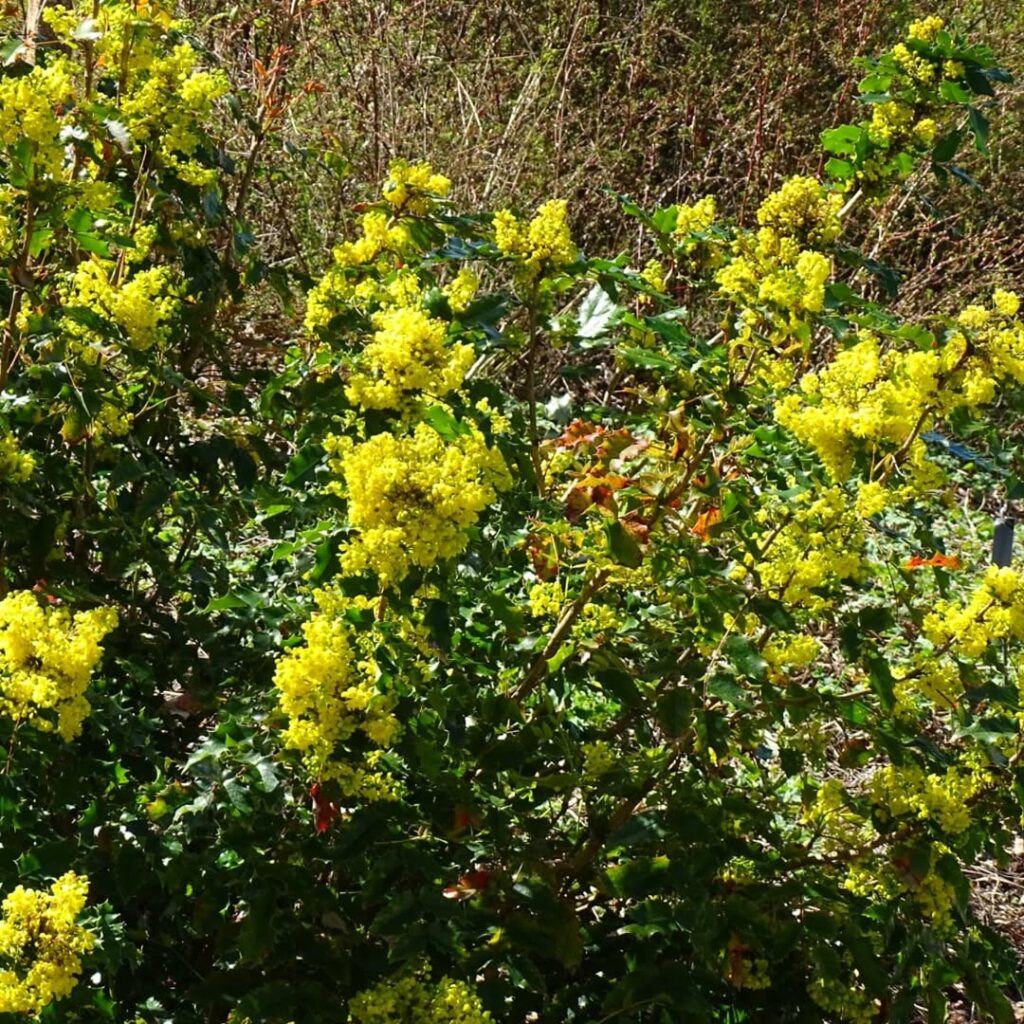
Oregon Grape is a versatile evergreen shrub native to western Washington, prized for its striking yellow flower clusters that bloom in spring. This hardy plant produces attractive blue berries and glossy, spiny-toothed leaves that add year-round interest to landscapes. Its adaptability to various growing conditions and excellent wildlife value make it an ideal choice for naturalized gardens, erosion control, and as an ornamental shrub.
The plant thrives in the Pacific Northwest’s climate and serves multiple functions in the landscape. From the taller Mahonia aquifolium reaching 10+ feet to the low-growing Mahonia repens at 1-2 feet, Oregon Grape offers options for different garden needs while providing important habitat for local wildlife. The shrub supports butterfly larvae including the brown elfin butterfly, making it valuable for pollinator conservation.
- Hardiness: Hardy in western Washington’s climate zones
- Light: Prefers dry shade but tolerates some sun exposure
- Water: Drought tolerant once established; moderate water during establishment
- Soil: Tolerant of wide range including poor and dry soils
- Fertilizer: Low maintenance; typically does not require fertilization
- Pest/Disease Resistance: Generally disease resistant with few pest issues
- Growth Rate: Moderate growth rate; spreads via underground stems
Salmonberry

Salmonberry is a deciduous native shrub that forms dense thickets through underground rhizomes, making it excellent for erosion control and naturalistic landscaping. Growing 3-13 feet tall with a spread up to 30 feet, it produces showy pink to reddish-purple flowers followed by yellow to orange-red berries resembling raspberries.
This versatile shrub thrives in moist locations like streambanks and wetlands, offering significant wildlife value through nectar-rich blooms that attract pollinators and edible berries that feed birds and small mammals. The young shoots are also edible, providing traditional food sources. While ideal for restoration projects and wild gardens, salmonberry requires management in formal landscapes due to its aggressive spreading nature.
The shrub develops distinctive orange flaky bark on older stems, contrasting with the green thorny appearance of new growth.
- Hardiness: USDA zones 6-9, tolerates Pacific Northwest conditions well
- Light: Full sun to partial shade; flowers and fruits best in full sun
- Water: Prefers consistently moist soil; tolerates wet conditions and seasonal flooding
- Soil: Moist, fertile, acidic soils preferred; adapts to various soil types if not overly dry
- Fertilizer: Minimal fertilizer needs; benefits from organic matter in soil
- Pest/Disease Resistance: Generally pest and disease resistant; few major issues
- Growth Rate: Moderate growth rate of 12-24 inches per year
Red Huckleberry
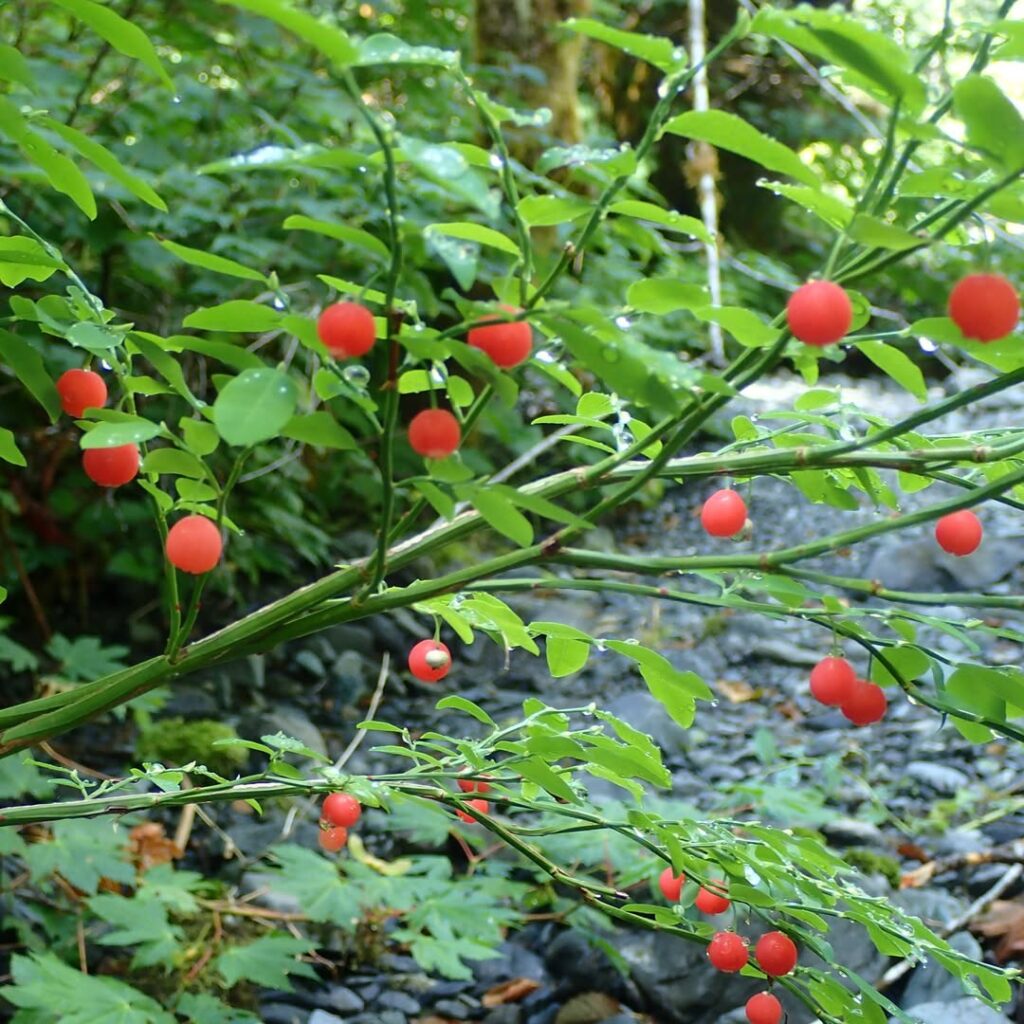
Red huckleberry is a graceful deciduous shrub native to Pacific coastal forests, perfectly adapted to Western Washington’s understory environments. This iconic Pacific Northwest plant produces small, urn-shaped creamy-pink flowers in spring followed by bright red berries high in vitamin C. With its slender green branches and small oval leaves, it typically grows 4-10 feet tall and thrives in shaded woodland settings.
The berries provide valuable wildlife food while offering culinary potential for jellies and fresh eating. Red huckleberry’s open, textured habit makes it excellent for naturalistic landscapes, woodland gardens, and erosion control. Its cultural significance to Indigenous peoples and role in forest ecosystems make it both an educational and ecologically beneficial addition to native plant gardens. The berries are sometimes used as fishing bait in streams where they resemble salmon eggs.
- Hardiness: USDA zones 6-9, well-adapted to Pacific Northwest climate
- Light: Partial to full shade; prefers indirect light under canopy
- Water: Consistent moisture; performs best with regular watering
- Soil: Acidic, humus-rich, well-draining soil with organic matter
- Fertilizer: Minimal needs; benefits from organic mulch and compost
- Pest/Disease Resistance: Generally resistant with few major issues
- Growth Rate: Moderate; reaches mature size in 5-8 years
Snowberry
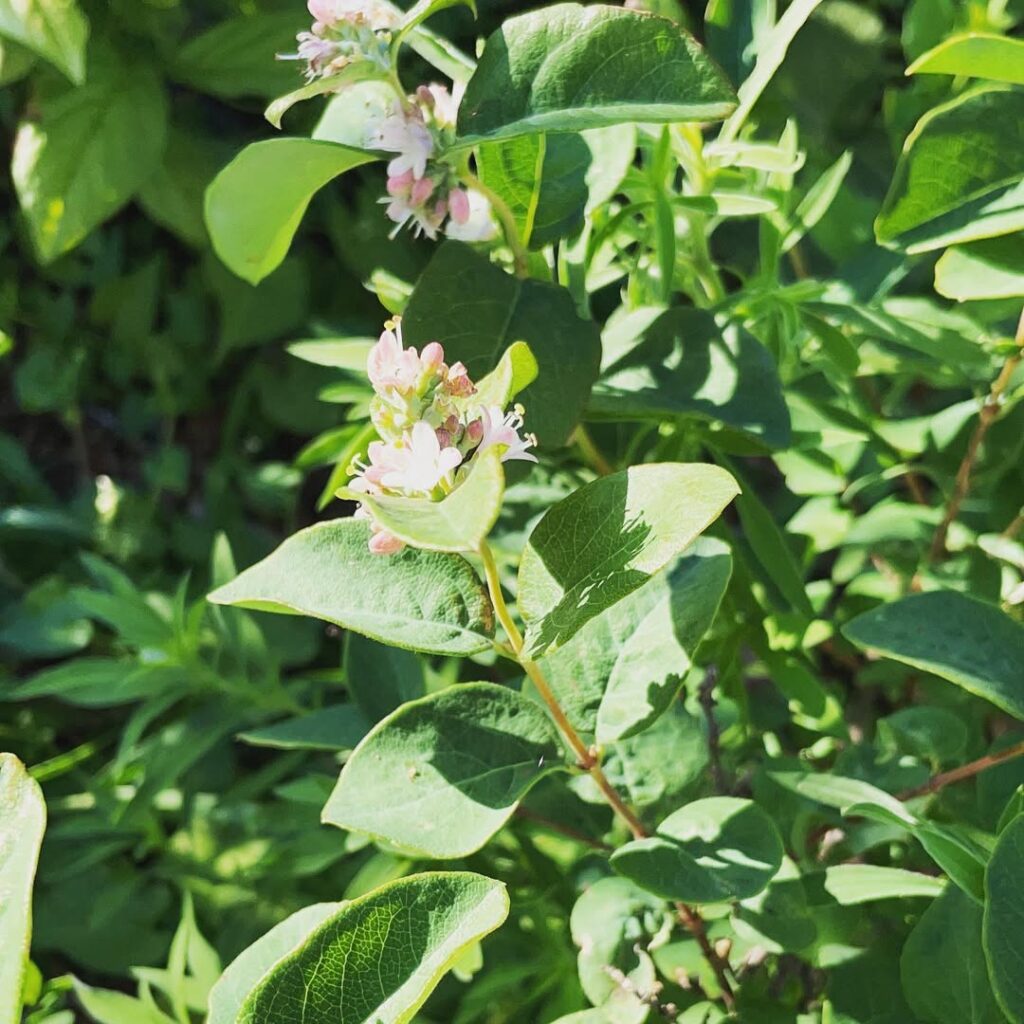
Snowberry is a versatile deciduous shrub native to the Pacific Northwest, growing up to 5 feet tall with distinctive white, waxy berries that persist through winter. This adaptable plant produces small pink flower clusters in spring and offers excellent wildlife value, supporting birds and pollinators while serving as one of the first species to recolonize disturbed areas. The berries are naturally high in saponins, making them historically valuable for traditional uses like shampoo and medicinal treatments.
Its delicate appearance and airy foliage make it ideal for mixed plantings with similar-height natives like red osier dogwood and Oregon grape. Perfect for woodland gardens, pollinator gardens, and erosion control, snowberry thrives in various conditions and provides year-round interest through its persistent white berries.
- Hardiness: Zones 3-7, native to Pacific Northwest from Alaska to California
- Light: Full sun to full shade, highly adaptable to various light conditions
- Water: Dry to moist conditions, drought-tolerant once established
- Soil: Adaptable to various soil types, thrives in well-draining woodland soils
- Fertilizer: Low maintenance, no supplemental fertilizer typically needed
- Pest/Disease Resistance: Generally pest and disease resistant, very hardy
- Growth Rate: Fast-growing, spreads by underground rhizomes but not overly aggressive
Pacific Ninebark
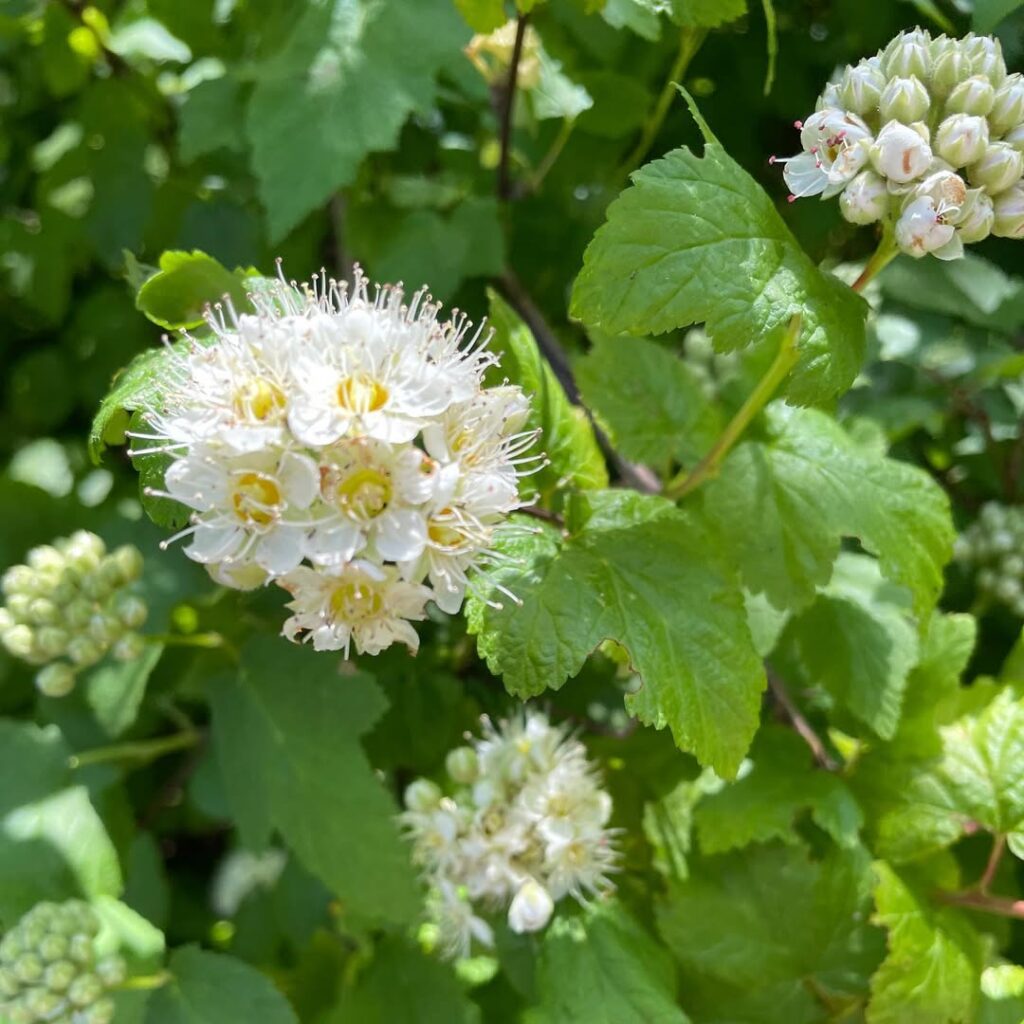
Pacific Ninebark is a deciduous shrub native to the west coast of North America, distinguished by its exfoliating bark that peels in thin layers. Growing 6-12 feet tall with a vase-shaped habit, it produces clusters of small white flowers with yellow centers from April through July. The foliage resembles grape leaves and turns vibrant red to rose-brown in fall.
This versatile shrub excels in both naturalized and formal landscape settings, offering four-season interest through its attractive bark, blooms, fruit, and fall color. Its fibrous root system makes it excellent for erosion control along stream banks, while its ability to outcompete invasive species adds ecological value. The reddish papery fruits provide food for songbirds during autumn and winter months. The flowers are primarily pollinated by native bees and also attract visiting butterflies.
- Hardiness: Suitable for western Washington climates, thrives below 4,500 feet elevation
- Light: Full sun to part shade
- Water: Moist to wet conditions preferred; drought tolerant once established
- Soil: Adaptable to various soil types, naturally found on moist banks and north-facing slopes
- Fertilizer: Low maintenance with minimal fertilizer requirements
- Pest/Disease Resistance: Excellent resistance with no significant pest or disease problems
- Growth Rate: Aggressive growth rate, ideal for restoration projects and disturbed areas
Selecting the Right Native Plants for Your Garden
Three fundamental factors determine your success with native plants: understanding your site’s specific conditions, choosing species that match those conditions, and timing your planting correctly. Start by evaluating your soil type, moisture levels, and sun exposure patterns.
Clay soils retain moisture longer, making them perfect for Pacific willow or red osier dogwood. Sandy soils drain quickly, suiting kinnikinnick or shore pine better. Check drainage by digging a test hole after rain.
Match plants to light conditions carefully. Shade areas need species like red huckleberry or western sword fern, while sunny spots thrive with Oregon sunshine or serviceberry. Many native plants become drought-tolerant once established, reducing long-term maintenance requirements. Proper soil preparation and planting techniques during fall maximize establishment success.
Frequently Asked Questions
How Much Do Native Plants Typically Cost Compared to Non-Native Alternatives?
Native plant pricing runs considerably higher than non-natives in cost comparison studies. You’ll pay $12-$18 for 4-inch native perennials versus $2.50 for non-native alternatives, making natives roughly three times more expensive initially.
Where Can I Purchase Native Plants in Western Washington?
You’ll easily find native plant nurseries throughout Western Washington, from Woodbrook in Gig Harbor to Wildflowers Northwest in Maple Valley. You can also browse online plant retailers and regional directories for convenient sourcing options.
When Is the Best Time to Plant Native Species?
Fall planting’s your best bet for native species in Western Washington. You’ll get ideal root development from warm soil and cool air. Spring planting works too, but fall gives plants time to establish before summer stress.
Do Native Plants Require Special Fertilizers or Soil Amendments?
Like self-sufficient gardeners, native plants don’t require special fertilizers since they’re naturally adapted to local conditions. You’ll find native plant benefits include improved soil health with minimal amendments needed once established.
How Long Does It Take for Native Plants to Establish?
You’ll see native plants establish over 2-5 years, with the establishment timeline varying by species. Growth factors like proper fall planting, adequate watering, and invasive species removal greatly influence how quickly they’ll become self-sufficient.
